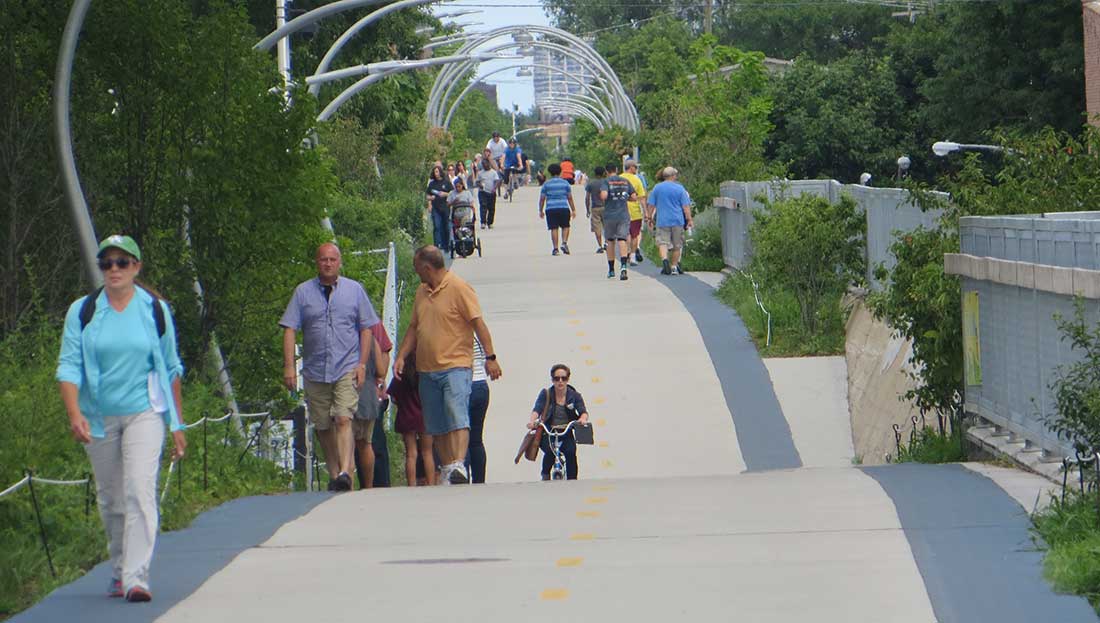By David Jordan
Nearly 16 months after opening, the 606 has come to define its surrounding neighborhoods, for better or for worse.
The 2.7-mile-long trail was developed by the Trust for Public Land, a national organization whose mission in part is to create and protect parkland, especially in underserved communities. Before the conversion of the Bloomingdale line into a public park, Logan Square had the least amount of green space per capita of any Chicago neighborhood.
When the organization looked to build a park there was little open space to do. “The reason the 606 came to be was a demonstrated community need,” said Jamie Simone, interim state director for the TPL Chicago Region Office. “[Vacant land] much more difficult to find in the neighborhoods the 606 goes through.”
This predicament forced planners and architects to look for a creative solution. After over a decade of coordination between public and private groups, the park opened last year to acclaim, earning the American Planning Association’s 2016 National Planning Excellence Award for Urban Design.
Over 80,000 residents live within a 10-minute walk, and thousands use the trail daily.
Alicia Smith comes from her home in Lincoln Park because she is fond of the 606 and enjoys not having to battle cars while jogging 17 feet above traffic. She was excited when the park was announced after falling in love with the High Line, a similar converted rail line in southern Manhattan, and followed the construction of the project until it was opened.
“I think it is great,” said Smith. “I just wish it was all across the city.”
The increased attention the 606 has brought to the surrounding neighborhoods has been controversial with some long-time residents, who feel the project has sped up gentrification in a part of the city that has seen a dramatic shift in population over the last decade.
The community area of Logan Square has seen the largest drop of Hispanic residents of any neighborhood in Chicago. Historically the area is home to a large Hispanic population, primarily Mexican and Puerto Rican, with a smaller Cuban minority.
The neighborhood has lost over 19,000 Hispanic residents in the past 16 years, according to data from the U.S. Census Bureau. In 2000 Hispanics accounted for 65 percent of the neighborhood’s population, but by 2010 the number had dropped to just 51 percent.
The 2014 estimate puts the number at just over 47 percent. Over the 16-year time period the white population has increased by nearly 11,000, and the trend shows whites will soon be the largest ethnicity in the neighborhood.
The success of the 606 is leading to a surge in real estate prices. Property developers have begun to plan for luxury high-rises on the eastern end of the trail while million dollar listings are increasingly common near the western edge in Humboldt Park. Due to the surge in interest the city reassessed taxes last year, leading to a surge of 60 percent in some areas.
This May, protestors took to the 606 hoping to draw attention to two ordinances they believe would slow down gentrification in Logan Square and Humboldt Park. Organized by the Logan Square Neighborhood Association, the group rallied for the proposed Property Tax Rebate Ordinance that would to give tax relief to low-income and working-class community members who own homes in affected neighborhoods, and give tax relief to two-to-four-flat owners who offer stable and affordable rents.
“Our families are being displaced from the community they love because housing costs are skyrocketing,” the Logan Square Neighborhood Association wrote in the press release announcing the protest. “We are glad you enjoy the trail—we do, too.”
Although the ordinance did eventually pass it did not extend relief to renters, who make up a large proportion of those being forced out.
Claire Marcin, who has lived in Humboldt Park for about a decade, says she hears more and more of her neighbors are opting to move further west to Hermosa or Belmont Cragin, or are leave the city entirely. “I’m in a position to stay in the neighborhood as it changes, but a lot of people who helped build a community here are no longer affording their rents,” said Marcin.
The TPL has worked with the affected communities and the city to provide resources to residents along the trail, working with community organizations. “When the issues came to a head we worked with the city and county,” said Simone. “[We worked to] convene meetings with the right people.”
Going forward, organizations the TPL hopes to consider how it can provide park space in underserved neighborhoods while ensuring that the residents they originally hoped to serve are not adversely affected. The trust is looking at how they can shift tactics in the future while still serving out their mission. “I’ve seen the conversation transit to ‘how can we use this for a case study,’” Simone added.


